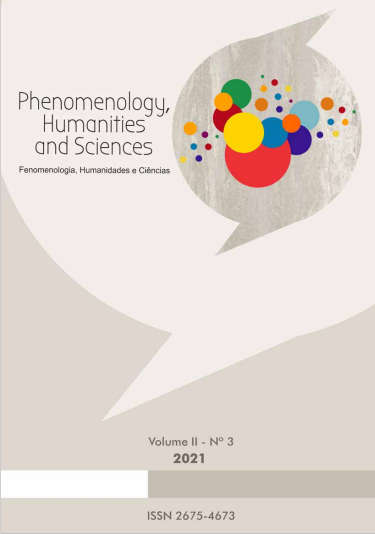The Psychic Subject and the Spiritual Subject in Ideas II
DOI:
https://doi.org/10.62506/phs.v2i3.113Keywords:
Husserl, Psyche, Spirit, Intersubjectivity, Lifeworld.Abstract
In this article I intend to highlight how the relationship between the psychic ego (seelischen Ich) and the spiritual ego (geistige Ich) is fundamental to the understanding of intersubjectivity and the lifeworld (Lebenswelt). In Ideas II, Husserl explains how, from the ego, natural, psychic and spiritual objectivities are constituted. These three strata of objectivity are known, first, in the theoretical attitude and, second, in the spiritual attitude. In this process, the ego becomes explicit. In the theoretical attitude, the constitution of nature takes place, for which the body (Körper/Leib) is fundamental. This is followed by the constitution of objects of psychic nature, human or animal (tierisch), including self-perception. In assuming the spiritual attitude, the other is perceived (Urpräsenz) initially as a body together with things, and alongside this perception there is an apprehension (Appräsenz) of co-given horizons. There is an identity between the body of others and mine; it is the moment of empathy (Einfühlung). The scientific world constituted in the theoretical attitude is a reduction of the surrounding world (Umwelt) – the lifeworld (Lebenswelt). This lifeworld is the world of spiritual attitude and precedes any comprehension or explanation of the world. It is therefore through the spiritual attitude that a community of spiritual subjects is constituted and constitutes the lifeworld.
References
Brainard, M. (2007) “For a New World”: On the practical impulse of Husserlian theory. Husserl Studies 23:17-31.
Cadena, N. (2019). The constitution of objectivities in consciousness in Ideas I and Ideias II. Revista Filosófica Aurora, Curitiba, v. 31, n. 53, p. 503-5019, maio/ago.
Cadena, N. (2017). Husserlian realism and transcendental idealism. Em Adriano Correia [et al.] (Orgs.), Fenomenologia e hermenêutica (pp. 64-75). São Paulo: ANPOF (XVII Encontro).
Husserl, E. (1950). Hua I. Cartesianische Meditationen und Pariser Vorträge. Hrsg. und eingeleitet von Stephan Strasser. Nachdruck der 2. verb. Auflage.
Husserl, E. (1960). Cartesian Meditations. An introduction to Phenomenology. (Translated by Dorion Cairns). London: Martinus Nijhoff Publishers.
Husserl, E. (2010). Meditações Cartesianas. Conferências de Paris. (Pedro M.S. Alves, Trad.) Braga: Tipografia Abreu, Souza & Braga, Lda.
Husserl, E. (1985). Meditaciones Cartesianas. (José Gaos e Migual García-Baró, Trads.) México: Fondo de Cultura Econômica.
Husserl, E. (1950). Hua III. Ideen zu einer reinen Phänomenologie und phänomenologischen Philosophie. Erstes Buch: Allgemeine Einführung in die reine Phänomenologie. The Hague: Martinus Nijhoff.
Husserl, E. (1983). Ideas Pertaining to a Pure Phenomenology and to a Phenomenological Philosophy. General Introduction to a Pure Phenomenology. First Book. (Translated by F. Kersten) Boston: Martinus Nijhoff Publishers.
Husserl, E. (2006). Ideias para uma fenomenologia pura e para uma filosofia fenomenológica. (Márcio Suzuki, Trad.) Aparecida, SP: Idéias & Letras. (Originalmente publicado em 1913)
Husserl, E. (1952). Hua IV. Ideen zu einer reinen Phänomenologie und phänomenologischen Philosophie. Zweites Buch: Phänomenologische Untersuchungen zur Konstitution. The Hague: Martinus Nijhoff.
Husserl, E. (1993). Ideas pertaining to a pure phenomenology and to a phenomenological philosophy. Studies in the Phenomenology of Constitution. Second book. (R. Rojcewicz and A. Schuwer, Trad.) The Hague: Kluwer Academic Publishers.
Husserl, E. (2005). Ideas relativas a una fenomenología pura y una filosofía fenomenológica. Libro segundo: Investigaciones fenomenológicas sobre la constitución. (Antonio Zirión, Trad.) México: UNAM, Instituto de Investigaciones Filosóficas, Fondo de Cultura Económica.
Husserl, E. (1975). Hua XVIII. Logische Untersuchungen. Erster Band: Prolegomena zur reinen Logik. The Hague: Martinus Nijhoff.
Husserl, E. (2005). Investigações Lógicas. Primeiro volume: Prolegómenos à Lógica Pura. (Diogo Ferrer, Trad.) Lisboa: Centro de Filosofia da Universidade de Lisboa.
Husserl, E. (1984). Hua XIX. Logische Untersuchungen. Zweiter Band: Untersuchungen zur Phänomenologie und Theorie der Erkenntnis. The Hague: Martinus Nijhoff.
Husserl, E. (1982). Logical Investigations. Volume 1. (Translated by J. N. Findlay) London: Routledge.
Husserl, E. (1982). Logical Investigations. Volume 2. (Translated by J. N. Findlay) London: Routledge.
Husserl, E. (2007). Investigações Lógicas. Segundo volume, Parte I: Investigações para a Fenomenologia e a Teoria do Conhecimento. (Pedro M. S. Alves e Carlos Aurélio Morujão, Trad.) Lisboa: Centro de Filosofia da Universidade de Lisboa.
Husserl, E. (2007). Investigações Lógicas. Segundo volume, Parte II: Investigações para a Fenomenologia e a Teoria do Conhecimento. (Carlos Aurélio Morujão, Trad.) Lisboa: Centro de Filosofia da Universidade de Lisboa.
Husserl, E. (1976). Investigaciones lógicas. (Manuel G. Morente y José Gaos, Trad.) Madrid: Revista de Occidente.
Husserl, E. (1976). Hua VI - Die Krisis der europäischen Wissenschaften und die transzendentale Phänomenologie. Eine Einleitung in die phänomenologische Philosophie. The Hague: Martinus Nijhoff.
Husserl, E. (1970). The Crisis of European Sciences and Transcendental Phenomenology. An Introduction to Phenomenological Philosophy. (David Carr, Translation) Evanston: Northwestern University Press.
Husserl, E. (2008). A crise das ciências europeias e a fenomenologia transcendental. Uma introdução à filosofia fenomenológica. (Diogo Falcão Ferrer, Trad.) Lisboa: Centro de Filosofia da Universidad de Lisboa.
Nenon, T. (2013). Intersubjectivity, Interculturality, and Realities in Husserl’s Research Manuscripts on the Life-World (Hua XXXIX). Em Rasmus Thybo Jensen and Dermot Moran (Orgs.), The Phenomenology of Embodied Subjectivity (pp. 143-163). Switzerland: Springer.
Tani, T. (1986). Life and the Life-world. Husserl Studies 3:57-78. Dordrecht: Martinus Nijhoff Publishers.
Zahavi, D. (2001). Husserl and Transcendental intersubjectivity. A Response to the Linguistic-Pragmetic Critique. Translated by Elizabeth A. Behnke. Athens: Ohio University Press.
Downloads
Published
How to Cite
Issue
Section
License
Copyright (c) 2022 Phenomenology, Humanities and Sciences

This work is licensed under a Creative Commons Attribution 4.0 International License.





